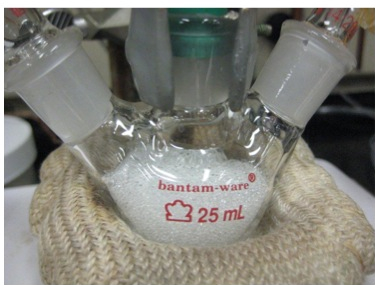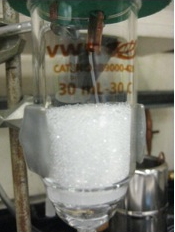2010 Annual Science Report
 NASA Jet Propulsion Laboratory - Titan
Reporting | SEP 2009 – AUG 2010
NASA Jet Propulsion Laboratory - Titan
Reporting | SEP 2009 – AUG 2010
Task 3.1.2 Heterogeneous Chemistry
Project Summary
There are a variety of heterogenous surface chemical processes possible in the Titan environment that can be simulated in laboratory experiments to determine how effective each may be in leading to the synthesis of prebiotic chemistry.
Project Progress
Titan’s N2-CH4 atmosphere provides the starting material for a wide array of organic compounds to be formed via photochemistry, and the presence of unsaturated hydrocarbon, amine, and polycyclic aromatic species has been supported by data from the Cassini-Huygens mission [Coates et al. 2009, Crary et al. 2009]. Production of tholins by UV irradiation of a simulated N2-CH4 environment has yielded products that match the observed optical properties of Titan haze, suggesting that these compounds provide suitable analogs to Titan aerosol compounds [Khare et al. 1984, Ramirez et al. 2002, Imanaka and Smith 2010].
Organics produced in Titan’s atmosphere eventually settle to the surface and very likely contribute to the particulate matter comprising the expansive longitudinal dune features observed at mid-latitudes [Lorenz et al. 2006]. Once on the surface, conditions that lead to incorporation of oxygen via contact with water ice or liquid water in Titan’s low temperature environment are of particular interest and have important implications for astrobiology [O’Brien et al. 2005], particularly since oxygen is present only in trace amounts in Titan’s atmosphere. In this work, graduate student Daniel Thomas and Co-Investigator Jack L. Beauchamp seek to demonstrate that the mechanical energy from wind-driven grains in the dunes of Titan can ultimately drive chemical processes and lead to the incorporation of oxygen into organic compounds via tribochemical reactions [Beyer and Clausen-Schaumann 2005].
While the exact composition of the dunes of Titan is unknown, it is likely that they mainly comprise organic and water ice particles approximately 0.2 mm in diameter, the ideal size for saltation by the winds of Titan [Lorenz et al. 2006]. During the saltation process, organic particles undergo charging due to friction between particles, leading in turn to formation of ions and free radicals in localized electrical discharges at particle interfaces [Kajdas and Hiratsuka 2009]. These reactive intermediates can initiate processes such as free radical and ionic polymerization that further transform organics. Of particular interest is the incorporation of oxygen into organic molecules, providing a pathway to the synthesis of biologically relevant compounds. Experiments modeling such systems are being conducted with laboratory-produced tholins and model unsaturated hydrocarbons, nitriles, imines, and aromatic compounds.
Two systems have been built for preliminary investigations. The first, Figure 1, uses a simple arrangement in which borosilicate beads are coated with unsaturated hydrocarbons and stirred in a round bottom flask. Nitrogen cooled by passing through a coil in liquid N2 flows over the beads to maintain temperatures approaching those on the surface of Titan. The second apparatus, Figure 2, utilizes a fluidized bed to agitate coated particles. Cold nitrogen gas passes through a frit up through a bed of coated particles. In both systems a small amount of water is injected after cooling to mix with organics as water ice. After a short period of agitation the beads become highly charged, and exhibit increased adhesion to each other and to the glass apparatus.
Following an extended period of agitation, the beads are heated and desorbed species are collected and analyzed by GC-mass spectrometry. These data indicate the formation of a substantial number of products in which oxygen is incorporated into precursor species.
Future experiments are planned in which a mixture of N2 and CH4 that simulates the composition of Titan’s atmosphere are passed over uncoated glass beads. They anticipate the possibility that complex organics can be formed directly by tribochemical processes, without the input of tholins formed by photochemical processes in Titan’s atmosphere.
References:
Coates, A. J., A. Wellbrock, G. R. Lewis, G. H. Jones, D. T. Young, F. J. Crary, and J. H. Waite Jr (2009), Planet. Space Sci., 57(14-15), 1866-1871.
Crary, F. J., B. A. Magee, K. Mandt, J. H. Waite Jr, J. Westlake, and D. T. Young (2009), Planet. Space Sci., 57(14-15), 1847-1856.
Khare, B. N., C. Sagan, E. T. Arakawa, F. Suits, T. A. Callcott, and M. W. Williams (1984), Icarus, 60(1), 127-137.
Ramirez, S. I., P. Coll, A. da Silva, R. Navarro-González, J. Lafait, and F. Raulin (2002), Icarus, 156(2), 515-529.
Imanaka, H., and M. A. Smith (2010), Proc. Natl. Acad. Sci. U.S.A., 107(28), 12423-12428.
Lorenz, R. D., et al. (2006), Science, 312(5774), 724-727.
O’Brien, D. P., R. D. Lorenz, and J. I. Lunine (2005), Icarus, 173(1), 243-253.
Neish, C. D., A. Somogyi, and M. A. Smith (2010), Astrobiology, 10(3), 337-347.
Beyer, M. K., and H. Clausen-Schaumann (2005), Chem. Rev., 105(8), 2921-2948.
Kajdas, C., and K. Hiratsuka (2009), Proc. Inst. Mech. Eng., Part J, 223(6), 827-848.
 Figure 1. Stirred reactor system for examining tribochemical reactions between water ice and organics coated on glass beads. Cold N2 gas passes over the beads. A magnetic stirring bar is used to agitate the particles, leading to tribocharging.
Figure 1. Stirred reactor system for examining tribochemical reactions between water ice and organics coated on glass beads. Cold N2 gas passes over the beads. A magnetic stirring bar is used to agitate the particles, leading to tribocharging.
 Figure 2. Fluidized bed reactor system for examining tribochemical reactions between water ice and organics coated on glass beads. Cold N2 gas passes through the glass frit on the bottom to lift and agitate the particles.
Figure 2. Fluidized bed reactor system for examining tribochemical reactions between water ice and organics coated on glass beads. Cold N2 gas passes through the glass frit on the bottom to lift and agitate the particles.
-
PROJECT INVESTIGATORS:
-
PROJECT MEMBERS:
Daniel Thomas
Graduate Student
-
RELATED OBJECTIVES:
Objective 1.1
Formation and evolution of habitable planets.
Objective 2.2
Outer Solar System exploration
Objective 3.1
Sources of prebiotic materials and catalysts
Objective 3.2
Origins and evolution of functional biomolecules
Objective 3.3
Origins of energy transduction
